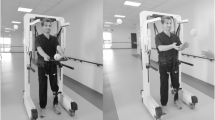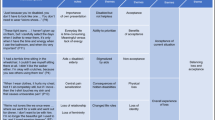Abstract
Study design
Qualitative descriptive study.
Objectives
To gain insight into if and how participation in intensive balance training impacted the daily lives and risk of falling of people living with incomplete spinal cord injury or disease (SCI/D), as well as to understand what motivated participation and what benefits and challenges, if any, they experienced while completing training.
Setting
Tertiary rehabilitation hospital.
Methods
Semi-structured interviews were conducted three to four months after 20 participants with incomplete SCI/D completed either Perturbation-based Balance Training or Conventional Intensive Balance Training as part of a randomized clinical trial. Interviews were transcribed verbatim and coded using conventional content analysis by two researchers. Codes were discussed for consensus, and subcategories and categories were created, which were confirmed by another two researchers.
Results
The following categories were identified: 1) goals of balance training, 2) valuable components of balance training, 3) physical gains from balance training, 4) psychosocial gains from participating in balance training, and 5) unique aspects of Perturbation-based Balance Training. Each category consisted of several subcategories.
Conclusions
Collecting qualitative data facilitated the evaluation of the meaningfulness of the balance training programs to the participants. These findings demonstrate that balance training was perceived as beneficial and enjoyable for individuals with incomplete SCI/D, and that these programs provided challenge and educational opportunities for the participants while improving balance confidence and reducing perceived fall risk. These findings have implications to direct future research studies or implementation of balance training in rehabilitation.
Similar content being viewed by others
Log in or create a free account to read this content
Gain free access to this article, as well as selected content from this journal and more on nature.com
or
Data availability
The datasets generated and/or analysed during the current study are not publicly available due to confidentiality of data, but are available from the corresponding author on reasonable request.
Change history
29 August 2022
A Correction to this paper has been published: https://doi.org/10.1038/s41393-022-00849-z
References
Teeter L, Gassaway J, Taylor S, LaBarbera J, McDowell S, Backus D, et al. Relationship of physical therapy inpatient rehabilitation interventions and patient characteristics to outcomes following spinal cord injury: the SCIRehab project. J Spinal Cord Med. 2012;35:503–26. https://doi.org/10.1179/2045772312Y.0000000058.
Khan A, Pujol C, Laylor M, Unic N, Pakosh M, Dawe J, et al. Falls after spinal cord injury: a systematic review and meta-analysis of incidence proportion and contributing factors. Spinal Cord 2019;57:526–39. https://doi.org/10.1038/s41393-019-0274-4.
Thigpen MT, Cauraugh J, Creel G, Day K, Flynn S, Fritz S, et al. Adaptation of postural responses during different standing perturbation conditions in individuals with incomplete spinal cord injury. Gait Posture 2009;29:113–8. https://doi.org/10.1016/j.gaitpost.2008.07.009.
Bone MD, Arora T, Musselman KE, Lanovaz JL, Linassi GA, Oates AR, et al. Investigating proactive balance control in individuals with incomplete spinal cord injury while walking on a known slippery surface. Neurosci Lett. 2021 Feb:135744. Journal Article by https://doi.org/10.1016/j.neulet.2021.135744.
Arora T, Musselman KE, Lanovaz JL, Linassi G, Arnold C, Milosavljevic S, et al. Reactive balance responses to an unexpected slip perturbation in individuals with incomplete spinal cord injury. Clin Biomech. 2020;78:105099. https://doi.org/10.1016/j.clinbiomech.2020.105099.
Chan K, Lee JW, Unger J, Yoo J, Masani K, Musselman KE, et al. Reactive stepping after a forward fall in people living with incomplete spinal cord injury or disease. Spinal Cord. 2019. Journal Article by https://doi.org/10.1038/s41393-019-0332-y.
Horak FB. Postural orientation and equilibrium: What do we need to know about neural control of balance to prevent falls? Age Ageing 2006;35(Suppl 2):ii7–11. https://doi.org/10.1093/ageing/afl077.
Maki BE, McIlroy WE. Control of rapid limb movements for balance recovery: age-related changes and implications for fall prevention. Age Ageing 2006;35(Suppl 2):ii12–8. https://doi.org/10.1093/ageing/afl078.
Mansfield A, Wong JS, Bryce J, Knorr S, Patterson KK. Does perturbation-based balance training prevent falls? Systematic review and meta-analysis of preliminary randomized controlled trials. Phys Ther. 2015;95:700–9. https://doi.org/10.2522/ptj.20140090.
Mansfield A, Inness EL, Komar J, Biasin L, Brunton K, Lakhani B, et al. Training rapid stepping responses in an individual with stroke. Phys Ther. 2011;91:958–69. https://doi.org/10.2522/ptj.20100212.
Mansfield A, Schinkel-Ivy A, Danells CJ, Aqui A, Aryan R, Biasin L, et al. Does perturbation training prevent falls after discharge from stroke rehabilitation? A prospective cohort study with historical control. J Stroke Cerebrovasc Dis. 2017;26:2174–80. https://doi.org/10.1016/j.jstrokecerebrovasdis.2017.04.041.
Unger J, Chan K, Lee JW, Craven BC, Mansfield A, Alavinia M, et al. The effect of perturbation-based balance training and conventional intensive balance training on reactive stepping ability in individuals with incomplete spinal cord injury or disease: A randomized clinical trial. Front Neurol. 2021;12:49 https://doi.org/10.3389/fneur.2021.620367.
Gerards MHG, McCrum C, Mansfield A, Meijer K. Perturbation-based balance training for falls reduction among older adults: Current evidence and implications for clinical practice. Geriatr Gerontol Int. 2017;17:2294–303. https://doi.org/10.1111/ggi.13082.
Unger J, Chan K, Scovil CY, Craven BC, Mansfield A, Masani K, et al. Intensive balance training for adults with incomplete spinal cord injuries: protocol for an assessor-blinded randomized clinical trial. Phys Ther. 2019;99:420–7. https://doi.org/10.1093/ptj/pzy153.
Merlo AR, Goodman A, McClenaghan BA, Fritz SL. Participants’ perspectives on the feasibility of a novel, intensive, task-specific intervention for individuals with chronic stroke: a qualitative analysis. Phys Ther. 2013;93:147–57. https://doi.org/10.2522/ptj.20110147.
Musselman KE, Shah M, Zariffa J. Rehabilitation technologies and interventions for individuals with spinal cord injury: Translational potential of current trends. J Neuroeng Rehabil. 2018;15:40 https://doi.org/10.1186/s12984-018-0386-7.
VanderKaay S, Moll SE, Gewurtz RE, Jindal P, Loyola-Sanchez A, Packham TL, et al. Qualitative research in rehabilitation science: opportunities, challenges, and future directions. Disabil Rehabil. 2018;40:705–13. https://doi.org/10.1080/09638288.2016.1261414.
Singh H, Shah M, Flett HM, Craven BC, Verrier MC, Musselman KE, et al. Perspectives of individuals with sub-acute spinal cord injury after personalized adapted locomotor training. Disabil Rehabil. 2018;40:820–8. https://doi.org/10.1080/09638288.2016.1277395.
Hsieh HF, Shannon SE. Three approaches to qualitative content analysis. Qual Health Res. 2005;15:1277–88. https://doi.org/10.1177/1049732305276687.
Guba EG. Criteria for assessing the trustworthiness of naturalistic inquiries. ECTJ. 1981;29:75–91. https://doi.org/10.1007/BF02766777.
Singh H, Craven BC, Flett HM, Kerry C, Jaglal SB, Silver MP, et al. Factors influencing fall prevention for patients with spinal cord injury from the perspectives of administrators in Canadian rehabilitation hospitals. BMC Health Serv Res. 2019;19:391 https://doi.org/10.1186/s12913-019-4233-8.
Singh H, Rosen AS, Bostick G, Kaiser A, Musselman KE. Exploring the causes and impacts of falls among ambulators with spinal cord injury using photovoice: a mixed-methods study. BMJ open. 2020;10:e039763. https://doi.org/10.1136/bmjopen-2020-039763.
Braun V, Clarke V. Using thematic analysis in psychology. Qual Res Psychol. 2006;3:77–101. https://doi.org/10.1191/1478088706qp063oa.
Acknowledgements
The authors would like to thank Dr. Olinda Habib-Perez for assisting with translation of one interview.
Funding
Funding was provided by the Ontario Neurotrauma Foundation to KEM (grant 2016-RHI-PREV-1019). The funder played no role in the development of the study design, in the collection, analysis and interpretation of data, in the writing of the report, or in the decision to submit the article for publication.
Author information
Authors and Affiliations
Contributions
JU contributed to study design, participant recruitment, data collection, data analysis, and drafting and revising the manuscript. HS contributed to study design, data collection, data analysis, and revising the manuscript. AV and KM contributed to data analysis and revising the manuscript. KEM contributed to study design, participant recruitment, data collection, data analysis, and drafting and revising the manuscript.
Corresponding author
Ethics declarations
Ethical approval
Ethical approval was obtained from the Research Ethics Board of the University Health Network (16-5685-DE). We certify that all applicable institutional and governmental regulations concerning the ethical use of human volunteers were followed during the course of this research.
Competing interests
The authors declare no competing interests.
Additional information
Publisher’s note Springer Nature remains neutral with regard to jurisdictional claims in published maps and institutional affiliations.
The original online version of this article was revised: Due to a misspelling in an author name.
Rights and permissions
Springer Nature or its licensor holds exclusive rights to this article under a publishing agreement with the author(s) or other rightsholder(s); author self-archiving of the accepted manuscript version of this article is solely governed by the terms of such publishing agreement and applicable law.
About this article
Cite this article
Unger, J., Singh, H., Mansfield, A. et al. The experiences of people with incomplete spinal cord injury or disease during intensive balance training and the impact of the program: A qualitative study. Spinal Cord 60, 1062–1068 (2022). https://doi.org/10.1038/s41393-022-00823-9
Received:
Revised:
Accepted:
Published:
Issue date:
DOI: https://doi.org/10.1038/s41393-022-00823-9



